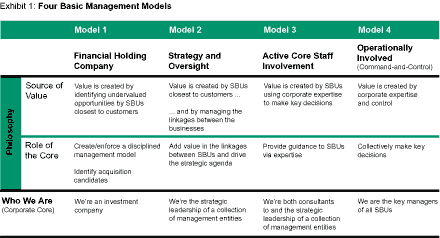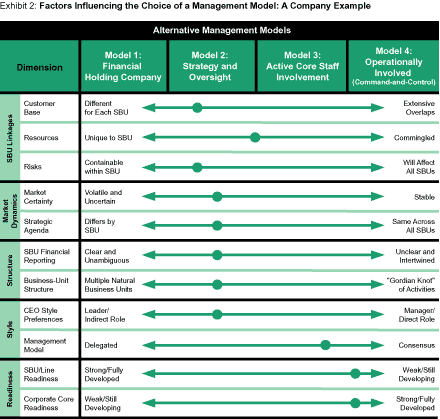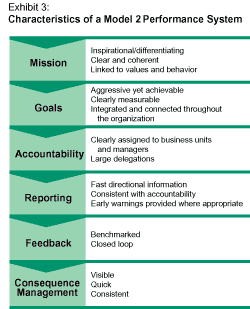The Model 2 Organization: Making Your Company Safe for Zealots
Centralized management still confounds corporations that need to be fast and flexible. There's a way to move from Taylorism to Welchism — but it means rejecting command-and-control.
 We've come a long way from the time when the father of scientific management, Frederick Winslow Taylor, yearned for a worker "so stupid and phlegmatic that he more nearly resembles an ox."
We've come a long way from the time when the father of scientific management, Frederick Winslow Taylor, yearned for a worker "so stupid and phlegmatic that he more nearly resembles an ox."
Or have we?
The fact is, businesses around the world remain mired in management practices far more appropriate to the early industrial era than to the entrepreneurial age. Micromanagement, inflexibility, bureaucracy, and rigid hierarchies still afflict companies, including many of the largest. Vestiges of Taylorism, these habits hobble firms facing accelerating globalization and consolidation, a quickening pace of R&D and time-to-market, and an environment in which intellectual capital is becoming more important than fixed assets.
Most diversified corporations need to accept that the corporate core (our term for what has traditionally been known as the head office) is no longer capable of dealing directly with the rapid pace of change. Delegation of decision-making to business-unit executives is essential to stimulate growth and meet shareholder requirements. Their increased autonomy will improve the speed and effectiveness of decision-making, as the decisions rest with those closest to the markets being served. The corporation itself will create value in the linkages between the businesses rather than in the businesses themselves.
Unfortunately, CEOs and CFOs are struggling to adapt to this new environment. They are still getting in the way of the new team-based corporation, networked by the latest information technology. Divisional presidents are clamoring for a longer leash to run their units as they believe best, responding zealously to the market forces around them. Their superiors, however, hesitate, concerned that with more autonomy comes more risk, that corporate alignment will be sacrificed, and that the company won't meet investor expectations. As a result, skirmishes are breaking out at more and more companies.
What keeps CEOs and CFOs from joining their division presidents in this leap of faith to a new organizational structure? We believe they hesitate because they cannot see a clearly laid-out path toward what we call the Model 2 organization.
We will lay out that path, because we believe that only this structure can ensure alignment throughout the organization and at the same time facilitate adaptability — the two factors identified as the keys to sustained financial success by a joint Booz-Allen & Hamilton and World Economic Forum research project. (See "Beyond the Cult of the CEO: Building Institutional Leadership," s+b, First Quarter 2001.) By becoming Model 2 organizations, companies can move beyond command-and-control, and capture the value that new technologies and business systems are injecting into the economy.
Management Models
Most corporations rely on one of four basic management models, differentiated by the kind of linkage between the corporate core and the strategic business units (SBUs). These differences reflect fundamentally distinct philosophies about how and where value is created. They range from the loosest structure, the financial holding company, which we call Model 1, to the tightest, usually referred to as command-and-control, in which the core management is directly involved in operations — our Model 4. Interestingly, Models 1 and 4 are most dependent on the "great person" theory — that a few highly skilled and intelligent people can add enormous value. Models 2 and 3 - the strategy and oversight structure and the active core staff involvement structure, respectively — depend on individuals who create value by leading rather than doing. (See Exhibit 1.)

Model 1, the Financial Holding Company, is used by Hanson Trust, Kohlberg Kravis Roberts & Company, and most private equity investment firms. These firms believe that value is created by picking the right companies to invest in, putting the right people into key management roles, and creating and enforcing a rigorous, disciplined performance management model. Thus, these firms have very few people in the corporate core (0.05 to 0.07 percent of total employees). They don't need a central human resources department or most other head-office departments because their companies operate almost entirely independently of one another. There is no management committee of operating-company heads — they might not even know one another. Rather, Model 1 companies depend on core executives' involvement in operating-unit boards to pass key ideas around. They see little need to get involved with how those ideas are implemented: The one and only test is whether solid financial results are produced. This model is not particularly attractive to most corporations, because it implies that the holding company provides little value to an operating company for a sustained period of time.
Model 2, Strategy and Oversight, is based on the philosophy that value is created in two places: at the operating companies closest to the customers and at the corporation, in the linkages between the operating companies. The corporate core is involved only in setting corporate strategy and policy, in identifying ways to create value above and beyond the operating companies' value (e.g., sharing best practices or creating businesses), and in creating and enforcing a disciplined performance management model. Like the Model 1 organization, a Model 2 company has a very small, highly focused head office (0.15 to 0.20 percent of total employees). In this model, coordination between businesses is important because the value created in the linkages between them pays for the corporate expenses: If no value is being created, why should the corporation exist? This model is found in companies whose businesses are substantially different from each other, including General Electric Company and Lucent Technologies Inc.
Model 3 companies, with Active Core Staff Involvement in the operating units, demonstrate a fundamentally different philosophy of where and how value is added. These companies strongly believe that participation by corporate-core staff in business-unit decision-making processes leads to improved performance by SBUs. Thus, accountability for results is shared between the head office and the SBUs. Because business units require the expertise of the corporate core, in these companies the core is larger (0.25 to 0.30 percent of employees) and the delegations of line managers smaller. This model is found most frequently in companies in which SBU risks are large or in which the lines between individual businesses are blurred, such as NationsBank and the premerger Exxon.
Model 4, Command-and-Control companies in which the head office is operationally involved, believe the head office contributes significant value by being actively and heavily involved in decision-making at the operational level. This model is frequently found in simple single-line businesses such as the Chevron Corporation and Emerson Electric Company, or those that have been under regulatory control, such as utilities. This substantive involvement in the activities of the businesses results in a rather large head office (0.35 to 0.40 percent) and substantially less autonomy for the managers running the SBUs.
Picking the Right Model
As an organization picks the model that will best support it, we believe five dimensions must be considered. The first two describe what the model should be and the other three constrain what the model can be:
- Business Linkages. Simply put, the less overlap in the customers, resources, or risks, the more autonomously the businesses should be run. Diversity requires that businesses have a high degree of freedom.
- Market Dynamics. Companies operating in stable markets could be run by command-and-control. In fast-changing markets, businesses need to be free to respond to and drive market developments.
- Structure. There is no sense in trying to manage businesses separately if they are so intertwined that decisions in one business will drive performance in another, or if the people required to manage the businesses independently are not available. Both of these constraints can be worked around, but they may limit the choice of models until they can be addressed.
- Style. Clearly, the CEO's personal style is critical in determining what management model will be used. So is the board's understanding of how well the CEO's style will work given the market requirements. A hands-off leader won't work well where command-and-control is required. A roll-up-your-sleeves executive who is heavily involved in operational decisions may not make a good CEO in a highly diversified company.
- Readiness. What the company aspires to and what it is capable of at a given point may not be aligned. There must be a strong performance ethic underpinning a Model 2 that usually does not exist in command-and-control organizations. This should not be an excuse for avoiding the Model 2 structure, but the performance ethic must be a part of the culture before the shift to Model 2 is attempted.

The choice of model is not always straightforward — several of these factors may conflict with one another. (See Exhibit 2.) In diversified companies, external factors (SBU linkages and market dynamics) tend to weight the decision toward Models 1 and 2; internal factors (structure, style, and readiness) toward Models 3 and 4. It is important to recognize that these internal dimensions are often historically rooted: They reflect the way the company has been managed, not the way it should be. Thus, these factors should be viewed as "correctable" — organizations can be redesigned, information systems and performance management models can be strengthened, and stronger executives can be promoted or brought in.
The Case for Model 2
Command-and-control is not necessarily outdated. In strategic rollups, the Model 4 approach is necessary when consolidating a variety of companies and trying to compete as a single institution. A Model 4 structure may also be appropriate in single-line businesses, when customers, resources, and strategic imperatives are common throughout the company. And it is often the only model that can be used in a major turnaround effort — especially one in which success is based on cost reduction.
Model 1, the holding company structure, is also a valid choice in some cases. In our experience, many divisional presidents say they would prefer to operate in a Model 1 environment: "Just leave me alone, and I'll get you the numbers."
But most diversified corporations need to accept that the corporate core is not capable of dealing directly with the rapid pace of change in today's markets — an argument against the Model 4 structure. And Model 1 prevents the corporate core from lending any strength to the business units. Adopting a Model 2 structure is perhaps the only way to ensure alignment and facilitate adaptability throughout the organization, enabling the corporation and its business units to identify common objectives, share understanding and information, develop standardized processes to support the objectives, perceive discontinuous threats and opportunities, communicate them to decision-makers, experiment with and implement new ideas, and institutionalize learning that supports growth.
The apparent simplicity of the philosophy underlying Model 2 can mask the huge operational changes required to implement it. Model 2 is not just a concept; it is a corporate way of life. It requires major retooling of executives in the core and in the business units.
First, the core steps out of operational issues and focuses on strategy, policy, and discussion with business units about their strategic agenda and commitments. The simple act of creating this focus triggers major changes. The core no longer provides business services — payroll, benefits administration, general accounting, and even legal services are either moved into a shared services unit, devolved to the businesses themselves, or eliminated. Those activities left in the core are done differently, to reflect a new policy orientation, and the roles of the leading executives change.
The chief financial officer's job undergoes the most pronounced change. First, the transactional activities that are usually within the CFO's purview take place elsewhere, changing the CFO's control function in style and in substance. Rather than approving expenditures several levels down in the budget, the CFO develops top-level financial policies and rigorous risk-management systems; rather than collecting ad hoc data to measure the performance of businesses, the CFO focuses on developing a performance management system. The goal is to ensure that the head of each business can discuss not just historical financial performance but also the operational measures that can predict future financials.
The CFO also takes a different, more active role in the strategic leadership of the corporation. Rather than setting top-down budgets after the usual bottom-up process, the CFO works with the businesses to develop an understanding of the potential of the business and what actions are required to capture that potential.
Second, the business units also have to change in Model 2, stepping up to a more autonomous role. SBU leaders have to make decisions where they can and should, rather than avoiding personal risk-taking by passing the decisions up. And they have to ask for help when they need it. They must develop an understanding of the potential of their business (going beyond previous years' budgets and actual performance) and demonstrate a sound game plan to close the gap between potential and actual. They determine what level of business services (HR, transactions, finance, legal, etc.) they need to run their business. But because these services are no longer provided by the core, which sets policy, the businesses have to consider how they will meet policy requirements: A requirement for functional excellence in business services shifts to a requirement for functional adequacy.
The changed relationship between the core and the business units in a Model 2 company influences many of the corporation's central activities.
• How the executive team interacts. The role of the management team as a group, the relationship between the CEO and the business-unit heads, and the relationship between the core and the business units all change dramatically.
In some cases, the executive team's composition is restructured, resulting in less involvement by executives in the core and more SBU leader involvement. Bigger changes come in the content of team discussions. Management committee meetings look and feel much different, whether they are held with the same frequency or less often. (One or two meetings a month generally proves adequate.) Although in Model 3 and Model 4 organizations the meetings are generally focused on operations, a change to Model 2 shifts the agenda to corporate strategy, cross-SBU issues, and communication.
With more autonomous SBUs, meetings of unit heads and the CEO increase in importance. For the SBU head, the meetings' objective is to demonstrate an understanding of the drivers of the business and the competitive situation and to articulate a cogent program to create additional value — in other words, to build the CEO's confidence that the SBU is being effectively managed. Detailed quarterly reviews of performance and monthly one-on-ones are usually adequate to accomplish these goals. For the CEO, the meetings present an opportunity to probe for risks, to play what-if games, and to calibrate the sense of trust and confidence in the managers responsible for each business.
The core has two key types of interactions with the business units. First, it must support the CEO's efforts to establish a performance contract with the business units. A performance framework must be developed, although the core must accept a diminished role in preparing feedback on performance. The business units should be responsible for reporting performance through the agreed-upon performance framework.
Second, the core identifies opportunities to create value strategically or operationally across SBUs. For example, the General Motors Corporation and Fiat SpA (in which GM now holds a 20 percent stake) share a platform across models and major product lines. The Lockheed Martin Corporation's drive to share best practices across all its business areas, in functions as diverse as engineering, program management, and operations, is another example.
• Decision-making processes and authorities. The shift to Model 2 brings much more autonomy for individual businesses. In most Model 3 or Model 4 organizations, authority that is delegated is usually low-level and based on a dollar value. In a Model 2 organization, the company reexamines how authority is delegated in the context of what it will take to compete most effectively. Can the businesses hire someone, and if so, whom? Can a line of credit be taken and for how much? How should pricing on a contract be structured? How much auditing is required to ensure the accuracy of financial reports? All this and more needs to be sorted out.
The company must decide and then make clear how much risk — and what kinds of risks — the CEO and the board are willing to delegate. Such risks do not necessarily correlate with size, something that many companies misunderstand. At some large industrial companies, for example, all new contracts above a certain threshold value have to be approved by the CEO — even if they reflect only a minor modification to an existing product and contract. On the other hand, new contracts, even in areas in which the company has no experience, are not subject to review if they fall below the dollar threshold, even though the risk to P&L can be substantially higher. In a more autonomous Model 2 structure, much clearer distinction of what defines risk is required. A robust risk-management system is a prerequisite to a move to Model 2. Without that system, the CEO feels too exposed to surprises.
• The planning and review cycle. The planning and review process in a Model 2 organization is significantly different from that in a Model 3 or Model 4. In many corporations today, the strategic planning department operates as a coordination point to integrate business-unit plans into an overall strategy, which is presented each year to the board for approval. Often there is no link with the financial planning process, which is managed separately by the CFO. To reconcile the different targets, the command-and-control organization manages each business unit closely and intervenes frequently.
By contrast, in a Model 2 organization, the strategic planning department does not set annual strategy or intervene in day-to-day execution of the business unit's strategy. Instead, it focuses on the company's three- to five-year horizon to develop the overall strategic framework that the business units use to develop consistent one- to two-year strategies. In one major bank, for example, the strategic planning department might undertake a review of the economics of the industry's value chain, hoping to identify which elements would be attractive for the bank to participate in over the longer term. After the strategic direction is approved by the executive team, the business units use it as a guide to develop their own strategies for value-chain positioning, which is then incorporated into their business plans.
To ensure that business units are operating within the overall strategic framework, it is very important that long-term strategic targets be fully integrated with shorter-term business-unit financial plans. This requires a much more sophisticated approach to target-setting than using "last year's performance plus some." Without this control, the CEO will be reluctant to surrender the control required for Model 2.
• How people are held accountable for results. Delegation and autonomy are based on trust, which (as we all know) must be earned. Business units earn their right to autonomy by delivering results, and the CEO must be comfortable that sufficient checks and balances are in place to enable timely identification of problem areas that require intervention.
Model 2 is about delegation — not abdication. It works only if a strong performance ethic is a core part of a company's culture. The performance ethic consists of six elements, encompassing both process and content. (See Exhibit 3.)
 All six elements must exist in strong form — weakness in any one of them can cause the system to unravel. Goals without a mission may result in short-term results but not long-term value creation; accountability without consequence management doesn't really exist.
All six elements must exist in strong form — weakness in any one of them can cause the system to unravel. Goals without a mission may result in short-term results but not long-term value creation; accountability without consequence management doesn't really exist.
A company's cultural components are also important: A performance ethic involves more than making money this quarter, or even this year. It involves building a business for the long term. Thus, the measurement system has to go beyond short-term financial reporting. Traditional financial measurements need to be augmented by three additional sets of measures: operational measures that provide insight into what the future economics of the business might be (a distribution business, for example, might measure route density or warehouse efficiency); institution-building measures (such as new customer acquisitions, patents received, or employee attrition rates); and measurements of adherence to the corporation's values (ethical or safety violations or harassment incidents, for instance).
• Size and structure of the core. With all of these changes in roles and responsibilities, what does a Model 2 corporate core look like? It's much smaller and more highly focused than Models 3 and 4. As previously mentioned, activities in the current head office are divided into two categories: those adding value in the linkages between the businesses, and those adding value to the businesses themselves.
The latter, as detailed above, should be moved to a shared services environment, devolved, or eliminated. Any functions left in the core will focus on five missions that enable the corporation to generate value over and above the business units:
Strategic Leadership — providing the vision, leadership, and purpose for growth; and initiating out-of-the-box thinking to generate future growth and to create a vibrant organization.
Identity — formulating a shared vision and set of values, and creating the most favorable corporate identity possible to motivate each relevant constituency.
Capital — minimizing its cost.
Capabilities — acting as a sourcing and disseminating "market-maker" to ensure corporate-wide access to world-class, low-cost capabilities.
Control — monitoring on behalf of the board and the shareholders, including monitoring the management of risk and values.
Rather than the 500- to 1,000-person — or more — head office found in many corporations, a Model 2 corporate core usually contains 100 to 200 highly skilled people, depending on the size of the company.
Although we believe a Model 2 structure offers great potential for performance benefits in today's uncertain and rapidly changing environment, we know that making a successful transition requires much more than moving the lines and boxes or expounding a new philosophy.
Building such an organization requires a mind-set, at both the corporate and business-unit level, of empowerment and trust. That, in turn, requires a massive upgrade of management processes for setting targets, reviewing performance, and managing consequences. The task is formidable, the investments substantial — and the potential rewards enormous. ![]()
Reprint No. 01105
| Authors
Paul F. Kocourek, kocourek_paul@bah.com is a senior vice president with Booz Allen Hamilton in New York. He focuses on strategic transformation of companies facing changes in the competitive landscape or the regulatory environment. Paul Hyde, hyde_paul@bah.com Paul Hyde is a principal with Booz-Allen & Hamilton’s Organization and Strategic Leadership Competency Center. Based in the firm’s Sydney office, he has worked extensively in the financial services and health-care sectors. |



